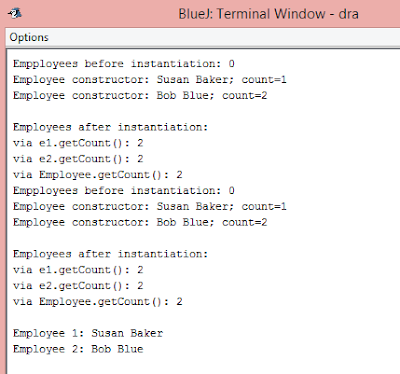Composition & Enumerations
A. COMPOSITION
Composition adalah dimana hubungan suatu object bergantung dengan objek lainnya.
Berikut ini program class Date, class Employee dan class EmployeeTest.
Source Code : Class Date
// Fig. 8.7: Date.java // Date class declaration. public class Date { private int month; private int day; private int year; private static final int[] daysPerMonth = //days in each month {0, 31, 28, 31, 30, 31, 30, 31, 31, 30, 31, 30, 31}; //contruktor : call checkMonth to confirm proper value for month; //call checkDay to confirm proper value for day public Date (int theMonth, int theDay, int theYear) { month = checkMonth(theMonth); year = theYear; day = checkDay(theDay); System.out.printf ("Date object constructor for date %s\n", this); } //utility method to confirm proper month value private int checkMonth(int testMonth) { if (testMonth > 0 && testMonth <= 12) return testMonth; else throw new IllegalArgumentException("Month must be 1 - 12"); } //utility method to confirm proper day value based on month and year private int checkDay(int testDay) { //check if day in range for month if(testDay > 0 && testDay <= daysPerMonth[month]) return testDay; //check for leap year if(month == 2 && testDay == 29 && ( year % 400 == 0 || (year % 4 == 0 && 100 != 0))) return testDay; throw new IllegalArgumentException("day out-of-range for the specified month and year"); } //return a String of the form month/day/year public String toString() { return String.format("%d/%d/%d", month, day, year); } }Souce Code : Class Employee// Fig. 8.8: Employee.java // Employee class with references to other objects. public class Employee { private String firstName; private String lastName; private Date birthDate; private Date hireDate; //contsructor to initialize name, birth date and hire date public Employee(String first, String last, Date dateOfBirth, Date dateOfHire) { firstName = first; lastName = last; birthDate = dateOfBirth; hireDate = dateOfHire; } //convert Employee to String format public String toString() { return String.format ("%s, %s Hired: %s Birthday: %s", lastName, firstName, hireDate, birthDate); } }Source Code : Class EmployeeTest// Fig. 8.9: EmployeeTest.java // Composition demonstration.public class EmployeeTest { public static void main (String[] agrs) { Date birth = new Date (7, 24, 1949); Date hire = new Date (3, 12, 1988); Employee employee = new Employee ("Bob", "Blue", birth, hire); System.out.println(employee); } }Output :B.ENUMERATIONSEnumeration adalah kumpulan nama-nama konstantayang didefinisikan sebagai tipe data baru.Source code : program tipe enum Book// Fig. 8.10: Book.java // Declaring an enum type with constructor and explicit instance fields // and accessors for these fields public enum Book { //declare constants of enum type JHTP("Java How to Program","2012"), CHTP("C How to Program", "2007"), IW3HTP("Internet & World Wide Web How to Program", "2008"), CPPHTP("C++ How to Program", "2012"), VBHTP("Visual Basic 2010 How to Program", "2011"), CSHARPHTP("Visual C# 2010 How to Program", "2011"); //instance fields private final String title; //book title private final String copyrightYear; //copyright year //enum constructor Book (String bookTitle, String year) { title = bookTitle; copyrightYear = year; } //accessor for field title public String getTitle() { return title; }//end method getTitle //accessor for field copyrightYear public String getCopyrightYear() { return copyrightYear; } }Source Code : EnumTestStatic Class Members Apabila sebuah variabel didefinisikan static didalam sebuah class, maka untuk memanggil variabel tersebut kita tidak perlu membuat objek dari class tersebut, namun langsung bisa memanggil variabel tersebut dari nama class dimana dia dideklarasikan.// Fig. 8.11: EnumTest.java // Testing enum type Book. public class EnumTest { public static void main (String[] args) { System.out.println ("All books:\n"); //print all books in enum Book for (Book book : Book.values()) System.out.printf ("%-10s%-45s%s\n", book, book.getTitle(), book.getCopyrightYear()); System.out.println ("\nDisplay a range of enum constants: \n"); //print first four books for (Book book : EnumSet.range (Book.JHTP, Book.CPPHTP)) System.out.printf ("%-10s%-45s%s\n", book, book.getTitle(), book.getCopyrightYear()); } }Output :Source Code : Class Employee1//// Fig. 8.12: Employee.java // Static variable used to maintain a count of the number of // Employee objects in memory. public class Employee1 { private String firstName; private String lastName; private static int count = 0; public Employee1(String first, String last) { firstName=first; lastName=last; ++count; System.out.printf( "Employee constructor: %s %s; count = %d\n", firstName, lastName, count); } public String getFirstName() { return firstName; } public String getLastName() { return lastName; } public static int getCount() { return count; } }Source Code : Emloyee Test// Fig. 8.13: EmployeeTest.java // static member demonstration. public class Employee1Test { public static void main(String[] args) { System.out.printf("Employees before instantiation: %d\n", Employee1.getCount() ); Employee1 e1 = new Employee1("Susan", "Baker"); Employee1 e2 = new Employee1("Bob", "Blue"); System.out.println("\nEmployees after instantiation: "); System.out.printf("via e1.getCount(): %d\n", e1.getCount()); System.out.printf("via e2.getCount(): %d\n", e2.getCount()); System.out.printf("via Employee1.getCount(): %d\n", Employee1.getCount()); System.out.printf("\nEmployee 1: %s %s\nEmployee 2: %s %s\n", e1.getFirstName(), e1.getLastName(), e2.getFirstName(), e2.getLastName()); e1 = null; e2 = null; } }Output :



Komentar
Posting Komentar